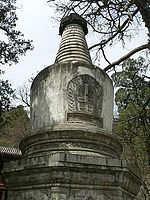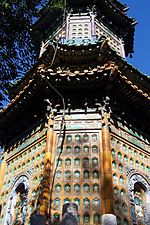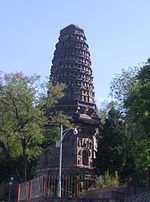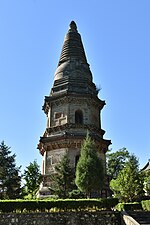| Pagoda | Image | Date of construction | Location | Description | Notes |
Beizheng Pagoda
北鄭塔 |
|
Liao dynasty, 1015 |
Beizheng Village, Changgou Township, Fangshan District
39.57°N 115.87°E / 39.57; 115.87 (Beizheng Pagoda) |
Octagonal, thirteen-tiered, multi-eaved style brick pagoda. |
On the site of the Chongfu Temple (崇福寺), founded during the Sui or Tang dynasties. The pagoda collapsed in June 1977, and more than 60 religious artefacts were recovered from the ruins.[5] |
Biyun Temple (Temple of Azure Clouds) Diamond throne pagoda
碧雲寺金剛寶座塔 |
 |
Qing dynasty, 1748 |
Fragrant Hills, Haidian District
39.9981°N 116.1899°E / 39.9981; 116.1899 (Temple of Azure Clouds Pagoda) |
Diamond throne pagoda, 34.7 metres (114 ft) in height. |
The Temple of Azure Clouds was founded during the Yuan dynasty, and the pagoda constructed as part of the renovation of the temple by the Qianlong Emperor in 1748. |
Cishou Temple Pagoda (Pagoda of Everlasting Peace and Long Age)
慈壽寺塔 (長安萬壽塔) |
 |
Ming dynasty, 1576 |
Linglong Park, Balizhuang, Haidian District
39.9268°N 116.2893°E / 39.9268; 116.2893 (Cishou Temple Pagoda) |
Octagonal, thirteen-tiered, multi-eaved style stone and brick pagoda, 50.0 metres (164.0 ft) in height. |
At Cishou Temple (慈壽寺), built in 1576 by the Wanli Emperor for the Empress Dowager Li.[3] |
Cloud Platform at Juyongguan
居庸關雲臺 |
 |
Yuan dynasty, 1342–1345 |
Juyongguan Pass, Changping District
40.289°N 116.068°E / 40.289; 116.068 (Cloud Platform at Juyongguan) |
A "straddling the street" style pagoda (過街塔), consisting of an arch base, on which three white stupa style pagodas were erected. |
Originally at the south gate to the Yongming Baoxiang Temple (永明寶相寺). The three pagodas on the arch had collapsed by the reign of the Zhengtong Emperor (1427–1464), and now only the arch remains. |
Dajue Temple Pagoda (Jialing Sarira Pagoda)
大覺寺塔 (迦陵舍利塔) |
 |
Qing dynasty, 1747 |
Xugezhuang Village, Haidian District
40.0515°N 116.1000°E / 40.0515; 116.1000 (Dajue Temple Pagoda) |
A white stupa style pagoda with an octaogonal base, 12.0 metres (39.4 ft) in height. |
Built to store the relics of the monk Jialing 迦陵 (d. 1726), who was abbot of the Dajue Temple during the 1720s. |
Duobao Glazed Pagoda
多寶琉璃塔 |
 |
Qing dynasty, 1735–1796 |
Summer Palace, Haidian District
39.9995°N 116.2707°E / 39.9995; 116.2707 (Duobao Glazed Pagoda) |
Three-storeyed pagoda covered with glazed statuettes of buddhas, with double or triple tiers of eaves on each storey. |
|
Fragrant Hills Pagoda
香山琉璃塔 |
 |
Qing dynasty, 1780 |
Fragrant Hills, Haidian District
39.9945°N 116.1910°E / 39.9945; 116.1910 (Fragrant Hills Pagoda) |
Octagonal-shaped pagoda with seven stories, 40 metres (130 ft) in height. |
|
Haotian Pagoda (Liangxiang Pagoda)
昊天塔 (良鄉塔) |
 |
Liao dynasty, 907–1125 |
Liangxiang, Fangshan District
39.7332°N 116.1480°E / 39.7332; 116.1480 (Haotian Pagoda) |
Five-storeyed octagonal, hollow brick pagoda, 26.7 metres (88 ft) in height.[6] |
Earliest pagoda on the site was constructed during the Sui dynasty (581–618). |
Jade Peak Pagoda
玉峰塔 |
 |
Qing dynasty, 1752 |
Jade Spring Hill, Summer Palace, Haidian District
39.9922°N 116.2425°E / 39.9922; 116.2425 (Jade Peak Pagoda) |
Octagonal, seven-storeyed brick and stone pagoda, 30.0 metres (98.4 ft) in height.[7] |
Built for the Qianlong Emperor in imitation of the Cishou Pagoda on the Golden Hill in Zhenjiang, Jiangsu. |
Lingguang Temple Pagoda
靈光寺塔 (佛牙舍利塔) |
 |
1964 |
Shijingshan District
39.9525°N 116.1814°E / 39.9525; 116.1814 (Lingguang Temple Pagoda) |
Octagonal, thirteen-storeyed pagoda, 51 metres (167 ft) in height. |
|
Luogong Pagoda at White Cloud Temple
白雲觀羅公塔 |
 |
Qing dynasty |
Xicheng District
39.901°N 116.3445°E / 39.901; 116.3445 (Luogong Pagoda) |
|
|
Miaoying Temple White Pagoda
妙應寺白塔 |
 |
Yuan dynasty, 1271–1279 |
Xicheng District
39.924°N 116.357°E / 39.924; 116.357 (Miaoying Temple White Pagoda) |
White, stupa style pagoda, 50.9 metres (167 ft) in height.[8] |
Built on the site of a Liao dynasty pagoda erected in 1092. The current pagoda was commissioned by Kublai Khan in 1271, and its construction was supervised by the Nepali architect Araniko. In 1978, many religious artefacts deposited in the pinnacle of the stupa in 1753 by the Qianlong Emperor were discovered.[2][9] |
Monk Wansong Pagoda
萬松老人塔 |
 |
Yuan and Qing dynasties |
Xicheng District
39.922°N 116.367°E / 39.922; 116.367 (Monk Wansong Pagoda) |
Octagonal, nine-storeyed, brick pagoda, 16 metres (52 ft) in height. |
A seven-storeyed brick pagoda was built to house the remains of Wansong Xingxiu (1166–1246), but a new nine-storeyed pagoda was built around the original pagoda in 1753, and the original pagoda was only rediscovered in 1986.[10] |
Qingshou Temple Twin Pagodas (Pagoda of Haiyun and Pagoda of Ke'an)
慶壽寺雙塔 (海雲塔、可庵塔) |
 |
Yuan dynasty |
Xicheng District
39.9055°N 116.3460°E / 39.9055; 116.3460 (Qingshou Temple Twin Pagodas) |
Two octagonal, multi-eaved style pagodas, one named after the temple's eminent abbot, the Chan master Haiyun 海雲 (1203–1257), the other named after Haiyun's disciple, Ke'an 可庵. The Pagoda of Haiyun was nine storeys high, and the Pagoda of Ke'an was seven storeys high. |
On the site of the Qingshou Temple (慶壽寺), which was founded during the Jin dynasty, in 1186. The two pagodas were demolished in 1954 to widen Chang'an Avenue.[11] |
Randeng Pagoda
燃燈塔 |
 |
Qing dynasty, 1696 |
Tongzhou District
39.9153°N 116.6667°E / 39.9153; 116.6667 (Randeng Pagoda) |
Octagonal, thirteen-storeyed brick and wooden pagoda, 53 metres (174 ft) in height. |
|
Silver Mountain Pagoda Forest (Yinshan Talin)
銀山塔林 |
 |
Liao dynasty and Jin dynasty, c. 1125 |
Southwest of Haizi Village, Changping District
40.318°N 116.324°E / 40.318; 116.324 (Silver Mountain Pagoda Forest) |
Seven octagonal, stone pagodas. |
A group of five pagodas built on the site of the Yanshou Temple (延壽寺), and two separate pagodas. Two of the pagodas date to the Liao dynasty, and five of the pagodas date to the Jin dynasty. The temples were destroyed during the Second Sino-Japanese War.[12] |
Tiankai Pagoda
天開塔 |
|
Liao dynasty, 1110 |
Tiankai Village, Yuegezhuangzhen, Fangshan District
39.6185°N 115.8885°E / 39.6185; 115.8885 (Tiankai Pagoda) |
Octagonal, three-storeyed, multi-storey style pagoda, 15.0 metres (49.2 ft) in height. |
On the site of the Tiankai Temple (天開寺), founded during the Tang dynasty. A pagoda was first built on this site during the Tang dynasty, but the present pagoda dates to the Liao dynasty. In 1990, more than 30 religious artefacts were recovered from the pagoda during emergency excavations to secure the safety of the pagoda. The pagoda was restored in 2005.[13] |
Tianning Temple pagoda
天寧寺塔 |
 |
Liao dynasty, c. 1120 |
Guang'anmen, Xicheng District
39.894°N 116.340°E / 39.894; 116.340 (Tianning Temple Pagoda) |
Octagonal, thirteen-storeyed, solid brick and stone pagoda, 57.8 metres (190 ft) in height. |
Supposedly built on the site of a wooden pagoda erected under Emperor Wen of Sui in 602.[1][14] |
Wayao Pagoda (Miyan Pagoda; Fengxiang Gongshou Pagoda)
瓦窑塔 (密檐塔, 峰香公壽塔) |
|
Ming dynasty |
Between Wayao Village and Liyuan Village, Wangzuo Township, Fengtai District
39.8150°N 116.1035°E / 39.8150; 116.1035 (Wayao Pagoda) |
Seven-tiered, multi-eaved style brick pagoda. |
On the site of a temple where there were originally several dozen multi-eaved style brick pagodas dating to the Jin, Yuan and Ming dynasties. All but one of these pagodas were destroyed during the Second Sino-Japanese War.[15] |
Wanfotang Ornamental Pagoda
萬佛堂花塔 |
 |
Liao dynasty, 1070 |
Hall of Ten Thousand Buddhas [zh], Hebei Township, Fengtai District
39.7892°N 115.9817°E / 39.7892; 115.9817 (Wanfotang Ornamental Pagoda) |
Octagonal, brick pagoda separated into three vertical sections, with the top section comprising nine layers with niches for Buddhist sculptures all around. |
There are inscriptions dating to the Liao, Jin and Yuan dynasties written in ink on the pagoda, including inscriptions dated the 6th year of the Xianyong era (1070) and the 7th year of the Shouchang era (1101). |
Wanfotang Multi-eaved Pagoda
萬佛堂密檐塔 |
 |
Yuan dynasty |
Hall of Ten Thousand Buddhas [zh], Hebei Township, Fengtai District
39.7892°N 115.9817°E / 39.7892; 115.9817 (Wanfotang Ornamental Pagoda) |
Seven-tiered, multi-eaved style brick pagoda. |
|
Wugou Pagoda (Nanguan Pagoda)
無垢凈光舍利塔 (南關塔) |
|
Liao dynasty, 1007–1013 |
Outside the southern gate of the old town, Shunyi District
40.10°N 116.65°E / 40.10; 116.65 (Wugou Pagoda) |
|
On the site of Yilin Temple (義林寺). Destroyed during an earthquake in 1720. In 1963 the underground hall of the pagoda was excavated, and about thirty religious artefacts were discovered.[16] |
Yao Guangxiao Pagoda
姚廣孝墓塔 |
 |
Ming dynasty, 1418 |
Changlesi Village, Qinglonghu Town, Fangshan District
39.820°N 116.080°E / 39.820; 116.080 (Yao Guangxiao Pagoda) |
Nine-storeyed pagoda, 33 metres (108 ft) in height. |
Master Yao Guangxiao (1335–1418) was buried underneath this pagoda. |
Yexian Pagoda
冶仙塔 |
|
Liao dynasty, 1039 |
Mount Ye, Miyun County
40.405°N 116.865°E / 40.405; 116.865 (Yexian Pagoda) |
Octagonal, three-storeyed, multi-storey style pagoda, 12.0 metres (39.4 ft) in height. |
On the site of the Puzhao Temple (普照寺). Destroyed in the mid 20th century. In 1988 the pagoda base was excavated, and more than 40 religious artefacts, as well as a large quantity of coins, were found.[17] |
Yong'an Temple White Pagoda (Beihai Park White Pagoda)
永安寺白塔 (北海公園白塔) |
 |
Qing dynasty, 1651 |
Qionghua Island, Beihai Park, Xicheng District
39.9245°N 116.383°E / 39.9245; 116.383 (Yong'an Temple Pagoda) |
White stupa style pagoda, 35.9 metres (118 ft) in height. |
Reconstructed in 1679 and 1731 after being severely damaged by earthquakes. Further repaired in 1976 after the Tangshan earthquake. |
Yongding Pagoda
永定塔 |
 |
2013 |
Fengtai District
39.8797°N 116.1725°E / 39.8797; 116.1725 (Yongding Pagoda) |
Octagonal wooden pagoda, 69.7 metres (229 ft) in height. |
A large wooden pagoda built for the Beijing International Garden Expo. |
Yunju Temple North Pagoda (Pagoda for Preserving Stone Scriptures)
雲居寺北塔 (續秘藏石經塔) |
 |
Liao dynasty, 1118 |
Fangshan District
39.6089°N 115.7671°E / 39.6089; 115.7671 (Yunju Temple Pagoda) |
Octagonal, eleven-tiered, multi-eaved style stone pagoda, 30 metres (98 ft) in height. |
Built to house Buddhist scriptures engraved on stone tablets during the reign of Emperor Daozong of Liao. Between 1957 and 1958 10,082 stone tablets engraved with Buddhist scriptures during the Liao and Jin dynasties were recovered from the underground hall in the pagoda.[18] |
Yunju Temple South Pagoda
雲居寺南塔 |
 |
2014 |
Fangshan District
39.6072°N 115.7677°E / 39.6072; 115.7677 (Yunju Temple Pagoda) |
|
First built in 1117, it was destroyed during the Second Sino-Japanese War, and it was rebuilt in 2014. |
Yunju Temple Stone Pagoda
雲居寺石塔 |
 |
Tang dynasty, 711 |
Fangshan District
39.9055°N 116.3460°E / 39.9055; 116.3460 (Yunju Temple Pagoda) |
A square-shaped stone pagoda. |
It is one of the few remaining Tang dynasty stone pagodas in the grounds of the temple complex. |
Zhenjue Temple Diamond throne pagoda
真覺寺金剛寶座塔 |
 |
Ming dynasty, 1473 |
Haidian District
39.943°N 116.324°E / 39.943; 116.324 (Zhenjue Temple Pagoda) |
Diamond throne pagoda, with a square base 7.7 metres (25 ft) in height, surmounted by four eleven-storeyed square-based pagodas at the corners and one thirteen-storeyed square-based pagoda in the middle. In total the diamond throne pagoda is 17 metres (56 ft) in height. |
Modelled after the Mahabodhi Temple in Bodh Gaya, India.[19] |
|
























